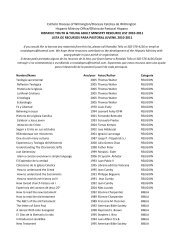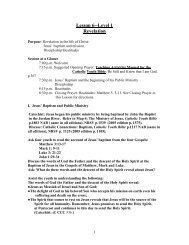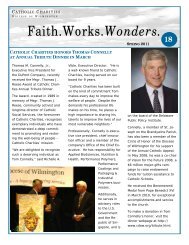to view the Guidelines for Catholic Funerals (PDF)
to view the Guidelines for Catholic Funerals (PDF)
to view the Guidelines for Catholic Funerals (PDF)
Create successful ePaper yourself
Turn your PDF publications into a flip-book with our unique Google optimized e-Paper software.
4<br />
RBCCF<br />
Norms <strong>for</strong> <strong>Catholic</strong> Burial<br />
Diocese of Wilming<strong>to</strong>n<br />
The <strong>Catholic</strong> Understanding of Death<br />
“In <strong>the</strong> face of death, <strong>the</strong> church confidently proclaims that God has created each person<br />
<strong>for</strong> eternal life and that Jesus, <strong>the</strong> Son of God, by his death and resurrection, has broken <strong>the</strong><br />
chains of sin and death that bound humanity. Christ ‘achieved his task of redeeming humanity<br />
and giving perfect glory <strong>to</strong> God, principally by <strong>the</strong> paschal mystery of his blessed passion,<br />
resurrection from <strong>the</strong> dead, and glorious ascension’.” (Order of Christian <strong>Funerals</strong> [OCF, 1])<br />
“At <strong>the</strong> death of a Christian, whose life of faith was begun in <strong>the</strong> waters of baptism and<br />
streng<strong>the</strong>ned at <strong>the</strong> Eucharistic table, <strong>the</strong> Church intercedes on behalf of <strong>the</strong> deceased because of<br />
her confident belief that death is not <strong>the</strong> end nor does it break <strong>the</strong> bonds <strong>for</strong>ged in life. The<br />
Church also ministers <strong>to</strong> <strong>the</strong> sorrowing and consoles <strong>the</strong>m in <strong>the</strong> funeral rites with <strong>the</strong> com<strong>for</strong>ting<br />
Word of God and <strong>the</strong> Sacrament of <strong>the</strong> Eucharist.” (OCF, 4)<br />
Through <strong>the</strong> celebration of <strong>the</strong> funeral rites, particularly <strong>the</strong> Vigil <strong>for</strong> <strong>the</strong> Deceased, <strong>the</strong><br />
Funeral Liturgy, and <strong>the</strong> Rite of Committal <strong>the</strong> Church calls <strong>for</strong> <strong>the</strong> active participation of all.<br />
I. General Principles and Norms<br />
1. In <strong>the</strong> Diocese of Wilming<strong>to</strong>n <strong>the</strong> Order of Christian <strong>Funerals</strong> (1989) is <strong>to</strong> be used as <strong>the</strong><br />
normative liturgical ritual <strong>for</strong> <strong>the</strong> celebration of <strong>the</strong> funeral rites.<br />
2. The three separate and sequential rituals in <strong>the</strong> funeral rites are: <strong>the</strong> Vigil and Related Rites and<br />
Prayers, <strong>the</strong> Funeral Liturgy (or Mass of Christian Burial) and <strong>the</strong> Rite of Committal. While<br />
<strong>the</strong>re are distinct rituals, <strong>the</strong> funeral rites as a whole are a single movement of prayer which need<br />
<strong>to</strong> be celebrated integrally. The General Introduction and <strong>the</strong> Introduction <strong>to</strong> each rite or group of<br />
rites, set <strong>for</strong>th guiding principles <strong>for</strong> <strong>the</strong> proper liturgical celebration of <strong>the</strong>se various rites.<br />
3. It is <strong>the</strong> responsibility of each pas<strong>to</strong>r <strong>to</strong> ensure that <strong>the</strong>se liturgical principles are<br />
respected, unders<strong>to</strong>od, and used with pas<strong>to</strong>ral sensitivity by all those, namely, priests,<br />
deacons, and lay persons, who participate in <strong>the</strong> ministry of consolation: <strong>to</strong> care <strong>for</strong> <strong>the</strong><br />
dying, <strong>to</strong> pray <strong>for</strong> <strong>the</strong> dead, <strong>to</strong> com<strong>for</strong>t those who mourn.<br />
4. Fur<strong>the</strong>rmore, it is <strong>the</strong> responsibility of <strong>the</strong> Pas<strong>to</strong>r <strong>to</strong> both in<strong>for</strong>m <strong>the</strong> funeral service<br />
providers of <strong>the</strong> proper order and liturgical expression of <strong>the</strong> funeral rites as set <strong>for</strong>th in <strong>the</strong><br />
Order of Christian <strong>Funerals</strong> and <strong>to</strong> ensure that <strong>the</strong>y are followed according <strong>to</strong> <strong>the</strong> desire of<br />
<strong>the</strong> Church.<br />
5. The Church encourages <strong>the</strong> full celebration of <strong>the</strong> funeral rites, especially <strong>the</strong> Funeral Mass,<br />
<strong>for</strong> her faithful deceased members. No one should be denied <strong>the</strong> Church’s funeral rites because<br />
of <strong>the</strong> neglect of <strong>the</strong> practice of <strong>the</strong> faith of <strong>the</strong>ir family members. It is <strong>the</strong> responsibility of <strong>the</strong><br />
Pas<strong>to</strong>r <strong>to</strong> ensure that <strong>the</strong> funeral rites are available <strong>for</strong> <strong>the</strong>se persons.<br />
6. Every <strong>Catholic</strong>, unless specifically excluded according <strong>to</strong> <strong>the</strong> norms of Church law, is entitled<br />
<strong>to</strong> <strong>the</strong> Church’s ministry at <strong>the</strong> time of death.








